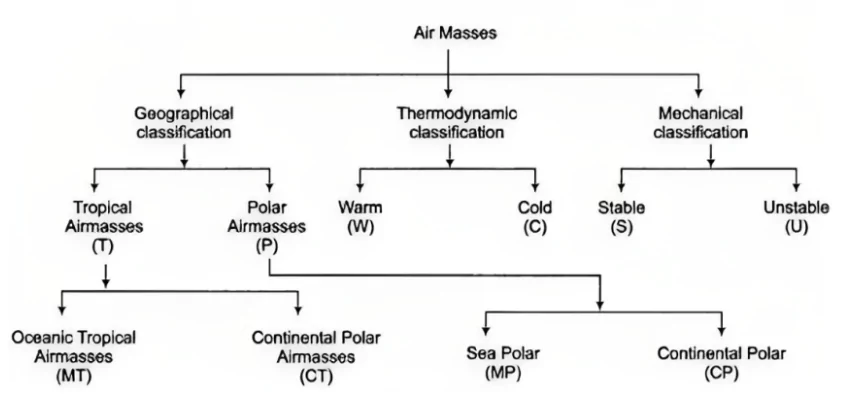![]() April 29, 2024
April 29, 2024
![]() 8342
8342
![]() 0
0
Air masses are like big blankets of air that have specific characteristics, such as temperature and humidity, and cover large areas. They form when air stays over one place for a while, like over a hot desert or a cold ocean. There are different types, like cold air masses from polar regions or warm ones from deserts, each bringing its kind of weather. When these air masses meet, they create boundaries called fronts, which can lead to changes in weather, like heavy rain or gentle showers.

| Types of Air Masses | ||
| Air Mass Type | Source Region | Characteristics |
| Continental Polar (cP) | Cold, dry land areas | Cold and dry, frigid temperatures, low humidity |
| Continental Tropical (cT) | Hot, desert regions | Hot and dry, high temperatures, low humidity |
| Maritime Polar (mP) | Cold oceanic regions | Cool and moist, cool to cold temperatures, moisture |
| Maritime Tropical (mT) | Warm oceanic regions | Warm and humid, warm temperatures, higher humidity |
| Continental Arctic (cA) | Polar regions | Extremely cold and very dry, bitterly cold, dry |
| Continental Equatorial (cE) | Desert regions near the equator | Extremely hot and dry, scorching temperatures, low humidity |
Types of Fronts Based on the Mechanism of Frontogenesis
| Must Read | |
| Current Affairs | Editorial Analysis |
| Upsc Notes | Upsc Blogs |
| NCERT Notes | Free Main Answer Writing |
| Related Articles | |
| Rising Earth Temperature: A Growing Crisis | Latitudes, Longitudes and Heat Zones |
| Indian Weather Seasons: Understanding the Annual Climate Cycle | Largest Desert in the World |
<div class="new-fform">
</div>

Latest Comments